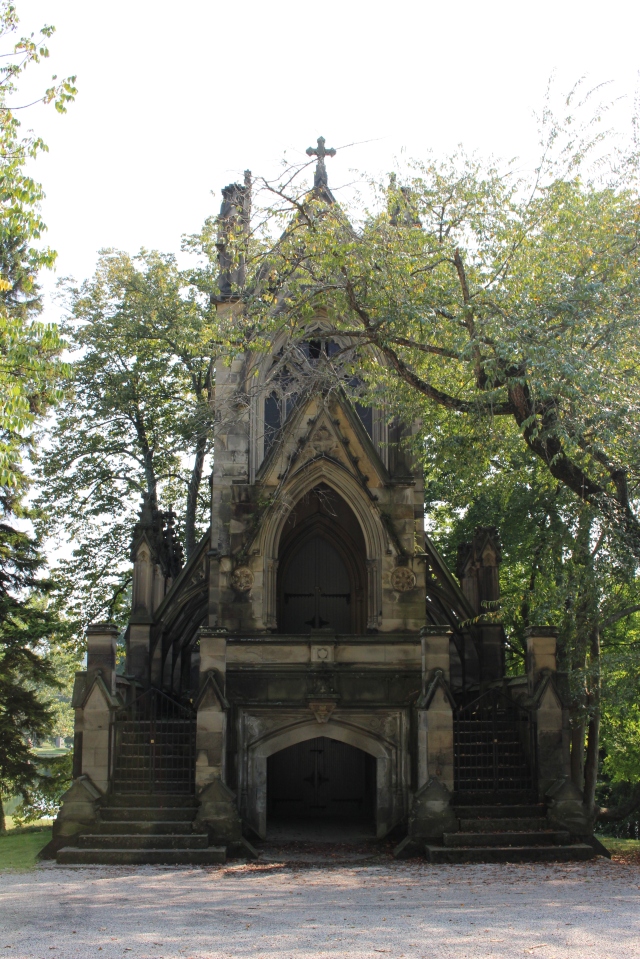Tucked away under some massive trees that form a canopy over a large part of the Dexter Family Mausoleum in the Spring Grove Cemetery in Cincinnati, Ohio, is a great Gothic Revival-style tomb. The sandstone mausoleum was designed for the Dexter brothers by famed Queen City architect James Keyes Wilson and inspired by the Sainte-Chappelle Cathedral in Paris. The tomb took four years to build between 1865 and 1869 at the exorbitant sum of $100,000, a staggering amount of money at the time. The first Dexter to be buried in the family tomb was Edmund Dexter who died at the age of 61 in 1862. Dexter was an English immigrant who made his fortune selling liquor in Cincinnati. He was buried in the tomb in 1870. Now nearly 20 family members are buried within the walls of the mausoleum.
The mausoleum was a curiosity from the beginning. People who took their carriage rides through the cemetery slowed or stopped to view the ostentatious tomb. The mausoleum has two distinct levels. The upper level was created as a chapel measuring 12 feet wide, 30 feet long, and 34 feet high. One of the features that makes Sainte-Chappelle so well-known are the magnificent stained-glass windows the recount the major events in the Bible from the Creation story to the Resurrection of Jesus Christ. Unfortunately, the chapel in the mausoleum was never completed so the stained-glass windows that had been planned for the chapel were never installed. The lower section of the mausoleum houses the crypts.
The massive tomb has many features of the medieval cathedral from which it was inspired. Typical of Gothic architecture, including Sainte-Chappelle, are the pointed arches which became popular in Western building designs during the 12th Century. Every window and nearly every door in the mausoleum do, indeed, have a pointed arch. Visually the pointed arch is lighter and also allowed builders to create taller windows which gave the buildings an airy feeling. In addition to the visual lightness, the pointed arch was stronger than the rounded arch which was popularized in Romanesque architectural designs. The arches are highly decorated with multiple moldings giving the windows a delicate appearance. Even though the moldings seem to be separate they are, in fact, carved together from the same blocks of stone—called voussoir blocks.
In addition to the decorative moldings each arched window has small decorative points projecting from the curves in the arch—this is known as cusping. These are formed using small curves. It is where these small curves meet and form a point or cusp. Lastly, each window has a hood molding that forms at the side of the window and then culminates in the pointed arch.
Flanking both sides of the tomb are flying buttresses. These highly decorative arches gave additional support to the walls within a building. The buttresses were positioned at the points of greatest stress and added additional structural support. Each of the flying buttresses are decorated with tall pinnacles which add weight to the buttress. The connecting pieces between the buttresses and the building are referred to as flyers and even those are highly decorated with tracery and quatrefoils.
Even though the Dexter Family Mausoleum has deteriorated and many of the decorative elements, such as turrets, spires, crockets, and pinnacles, have decayed, the tomb remains a magnificent example of Gothic architecture and continues to be one of the most-sought after sights in the Spring Grove Cemetery a century and a half after it was completed.
If you view the four pinnacles on these flying buttresses in the picture above, only one is complete. Tops of the pinnacles have fallen to the ground as well as the crockets. Crockets are the protruding and highly-stylized foliage sculptural decorative pieces adorning the pinnacles.
Some of the pinnacles are missing entirely.
The sandstone in the tracery is beginning to deteriorate.








Such a pity such a magnificent mausoleum is allowed to deteriorate